A batch dryer takes water out of things like grains, seeds, and food in one closed group. Farmers and people who process food use this machine to make products better and stop them from going bad. More people around the world are buying these machines. For example, batch grain dryers made $1.8 billion in 2023. They are mostly used for rice, wheat, and maize. Asia Pacific has the biggest share and is growing the fastest.
Metric | Value (USD Billion) | Year/Period |
|---|---|---|
Market size (Batch Grain Dryer) | 1.8 | 2023 |
Projected market size | 3.4 | 2032 |
CAGR | 7.5% | 2023-2032 |
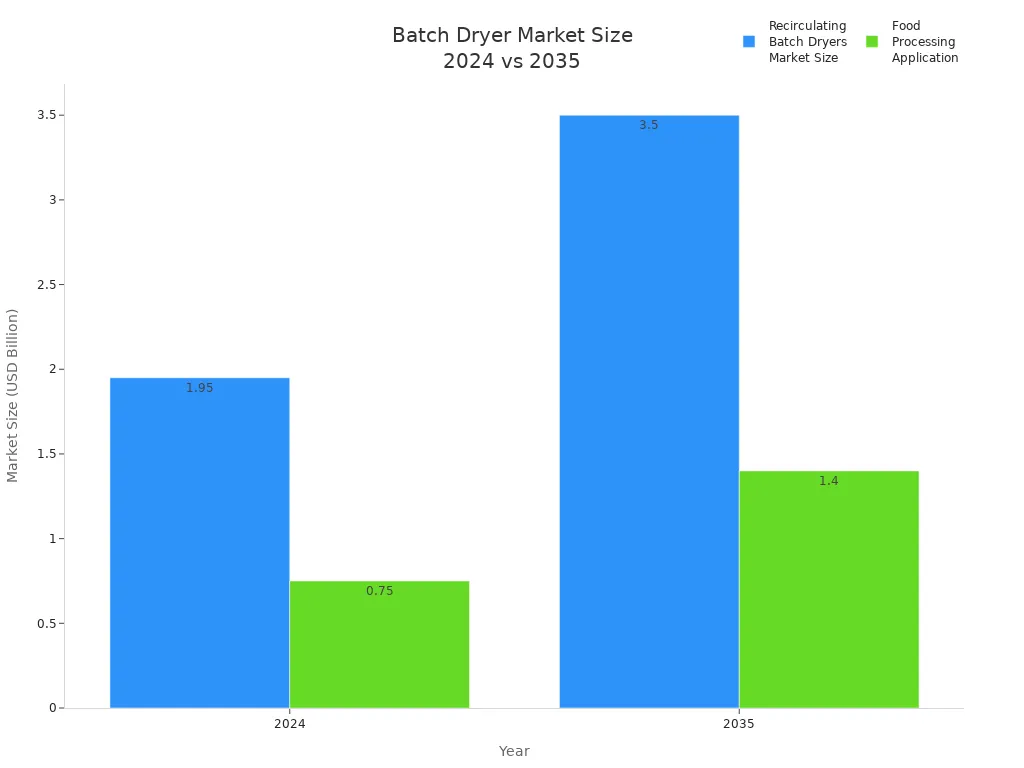
Knowing how batch dryers work helps workers use less energy and get the same results every time.
주요 내용
Batch dryers take water out of grains, seeds, and food in groups. Workers can control how things dry and how good the product is.
There are different batch dryers for different things and needs. Tray dryers are gentle. 진공 건조기 work for things that cannot take heat.
Good airflow, the right temperature, and careful loading help dry things the same way. These steps also help save energy when drying.
Batch dryers are good for small jobs and can dry many things. But they need more work and time than continuous dryers for big jobs.
Cleaning, fixing, and using batch dryers the right way keeps them safe. This also helps them work well and last longer.
What Are the Basic Principles of Batch Drying?
Batch drying involves removing moisture from a material in discrete quantities rather than continuously. It operates on the principle of loading a specific amount of material into a drying chamber, where it undergoes controlled heating and airflow until the desired moisture content is achieved.
정의
A batch dryer is a machine that takes water out of things like grains, seeds, or food. It works with one group of items at a time in a closed space. Workers put the material inside, dry it all together, and then take it out when done. This way, they can watch the time and heat closely. Many small farms and food makers use batch dryers. They like them because they can dry different things and change the settings for each group.
주요 기능
Batch dryers look different, but they have some things in common. Each kind uses its own way to heat and move the product. The table below lists the main types of batch dryers and what makes each special:
건조기 유형 | Core Components & Design Features | Distinguishing Characteristics |
|---|---|---|
Indirect Batch Dryer | Hot fluid moves through a jacket around a closed vessel holding the product. | Indirect drying is good for small or medium groups; keeps product safe from germs and damage; works for dangerous or toxic stuff. |
Cone shape on a sideways axis that spins all the way around; glass-lined steel to stop rust. | Mixes well and keeps the product touching the hot wall; lets solids out the bottom after turning upright. | |
패들 건조기 | Round vessel with many paddles inside; hot fluid goes through the wall and paddles. | Mixes and heats well; works for rough or lumpy solids; lets product out the bottom but may not empty all the way. |
Disc Dryer | Shell with a spinning part inside; slanted discs on the spinner; hot fluid moves through the shell, spinner, and discs. | Has lots of area for heat; can be used for one group or many; hard to clean, so not great for expensive solids. |
Note: Batch dryers help keep products clean and let workers handle sensitive or dangerous materials safely.
Batch vs. Continuous Dryers
Batch dryers and continuous dryers work in their own ways. A batch dryer dries one group at a time. Workers load the product, dry it, and then unload it before starting again. This gives more control over how things dry and helps keep the quality good.
Continuous dryers keep moving the product through without stopping. These machines dry a lot of stuff fast. Big factories use them when they need to dry lots of grain or food every day.
Some key differences are:
Continuous dryers dry more at once than batch dryers. They work faster with big amounts.
Continuous cross-flow dryers use a lot of fuel. For example, they might burn 34 liters of propane to dry one group.
Batch dryers show a steady rise in exhaust heat as things dry. This is not the same as continuous dryers.
Continuous dryers can save energy by reusing heat, but this can slow drying down.
Batch and continuous dryers lose heat in different ways. This changes how much energy they use and how easy they are to run.
A batch dryer is best when workers need to be flexible, want careful control, or have small groups to dry. Continuous dryers are better for jobs that need to be fast and handle a lot at once.
How Does a Batch Dryer Operate?
A batch dryer operates by circulating hot air through a chamber where materials are placed, effectively removing moisture. The process involves controlled temperature and airflow to ensure even drying.
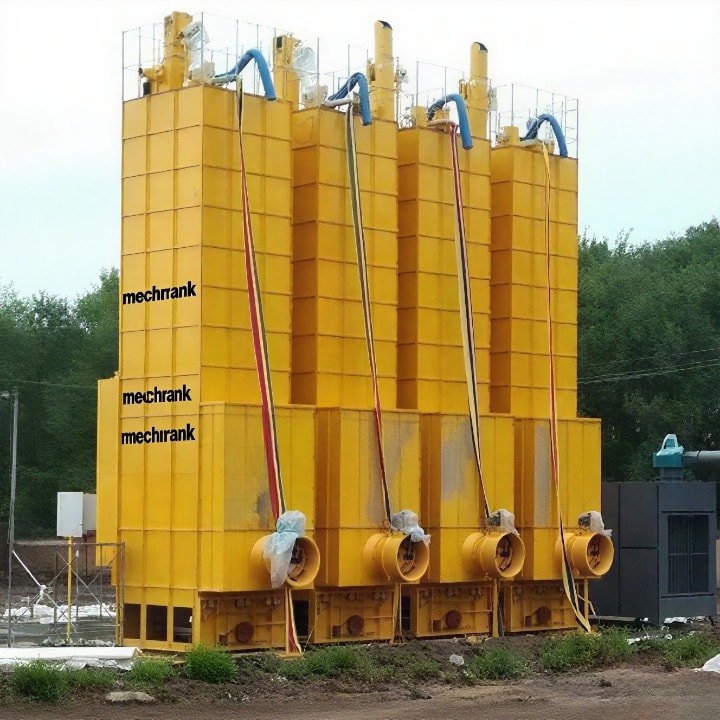
작동 방식
A batch dryer dries things in a few simple steps. Each step helps keep the process safe and easy. Here is what usually happens during drying:
Workers put grain or food into the drying chamber. They use machines to spread it out evenly. This stops too much from piling up. Air can move through the batch better this way.
Operators pick the right 건조 온도 on the control panel. They change the burners or heaters to keep the product safe from too much heat.
During drying, they check how wet the product is. They use sensors or test by hand. This helps them know when the product is dry enough.
When drying is done, workers take out the batch with machines. They handle the dried product gently so it does not break. They store it in a dry place.
Drying time and temperature can change for each product. The table below shows some common numbers for food and grain:
Aspect | 세부 정보 |
|---|---|
건조 시간 | 1 to 4 hours, depending on moisture, grain type, air temperature, and bed depth |
Temperature Range | Seed corn: up to 110 °F (43 °C); feed corn: up to 180 °F (82 °C) |
Batch Drying Method | Heated air flows through a grain bed about 0.5 m thick; thin layers (5-10 cm) for bin-batch |
Temperature Consideration | Heated air speeds up drying, but kernel temperature must stay safe to avoid damage |
Equipment Notes | Roof dryers reduce unloading time but cost more; stirring systems improve moisture uniformity |
Tip: Always watch the temperature and moisture to keep the product good.
Airflow and Heating
Airflow and heating are very important for batch dryers. Good airflow helps dry everything evenly and quickly. Here are some main things to know:
Heated air that spreads out well and moves the product gives the best results. Machines like spinning rods or belts help move the product so all parts get warm air.
Fans push hot air through the chamber and take out wet air. This keeps drying steady.
Digital sensors near fans check the airflow. They help stop hot or cold spots inside the dryer.
Moisture sensors send data to a control system. The system can change heaters, fans, and motors to keep drying just right.
Moisture graphs often show water going down over time. This means airflow and movement are working well.
Batch dryers use different ways to heat. Each way changes how much energy is used and how fast things dry:
Ambient air drying works best when the weather is dry. It uses little energy, mostly for fans.
Low-temperature heating, like solar or electric, adds some heat but does not make it much hotter.
High-temperature gas dryers with stirring can dry faster and use less energy, saving up to 25%.
Hybrid solar dryers with biogas backup dry things faster and save more energy than electric-only dryers.
Electric backup heaters make drying faster but use more energy and cost more to set up.
Note: Pick the best heating method for your weather, energy cost, and product type.
로드 및 언로드
Loading and unloading are key steps in batch drying. Good handling keeps the product safe and helps the dryer work well.
Workers load the product evenly so air can reach every part. They use machines to spread it out.
Too much product can block air and cause uneven drying. Operators must not go over the dryer’s limit.
After drying, they unload the product carefully. Gentle handling stops grains and seeds from breaking.
The dried product should go right to a dry storage area to keep it safe from water.
Batch dryers often use batch cycling. This means they repeat loading, drying, and unloading for each new group. Big machines can do these steps faster, but most dryers do one batch each day.
Reminder: Clean the dryer after each batch so leftover stuff does not hurt the next load.
What Are the Different Types of Batch Dryers?
Batch dryers come in several types, each suited to different drying needs. The main types include tray dryers, vacuum dryers, freeze dryers, and fluid bed dryers.
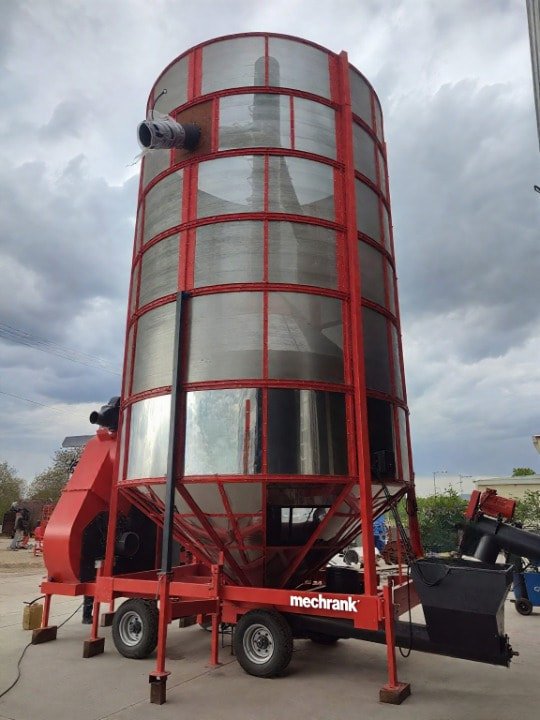
트레이 건조기
Tray dryers have trays stacked inside a closed chamber. Hot air moves over the trays to dry what is inside. Fans help move the air, and wet air leaves through an exhaust. These dryers are used for food, medicine, and chemicals. They can dry powders, fruits, vegetables, herbs, and colors. Tray dryers are simple and cost less than other dryers. They take longer to dry thick layers, sometimes 12 to 24 hours. Workers must put in and take out trays by hand, which takes more time. Tray dryers are best for small groups and things that need gentle drying.
Common uses: Bakery products, fruits, vegetables, chemicals, pharmaceuticals, pigments
장점: Versatile, gentle drying, easy to clean
단점: Long drying times, low output, more manual work
진공 건조기
Vacuum dryers take out water by lowering the pressure inside. This makes water boil at a lower heat. Heat comes from steam or hot water in the walls or shelves. A vacuum pump pulls out the vapor, and a condenser collects it. Vacuum dryers are best for things that cannot handle high heat, like medicines, proteins, and vaccines. They dry faster than regular dryers and help keep things safe. Many chemical, pharmaceutical, and food companies use vacuum dryers to protect delicate products.
Vacuum dryers help keep product quality high and make drying faster for sensitive items.
Fluidized Bed Dryers
유동층 건조기 blow hot air up through small particles. The air lifts and mixes the particles so they move like a liquid. This dries each piece quickly and evenly. Fluidized bed dryers do not take up much space and cost less to set up. They are good for drying tablets, grains, and powders. These dryers are easy to run and handle things gently. They also make products that do not stick together.
Key benefits: Fast drying, uniform results, low labor, easy control
Agricultural and Small-Scale Types
Farmers and small producers use special batch dryers like solar dryers, circular bin dryers, and cabinet dryers. Solar dryers use the sun’s heat to dry food, which saves energy and money. They keep food safe from rain and dust, so it is safer to eat and store. Circular bin dryers push hot air up through grains in a big bin. This type can dry large amounts and is good after harvest. Cabinet dryers have shelves inside a box and can use solar or electric power. These dryers help small farms dry crops so they last longer and sell for better prices.
Solar dryers help farmers lose less food and make food better by using clean energy.
What are the Pros, Cons, and Uses of a Batch Dryer?
Batch dryers are effective for drying small quantities of materials with high precision. They offer flexibility in processing various materials and ensure uniform drying. However, they have lower throughput compared to continuous dryers and can be labor-intensive.
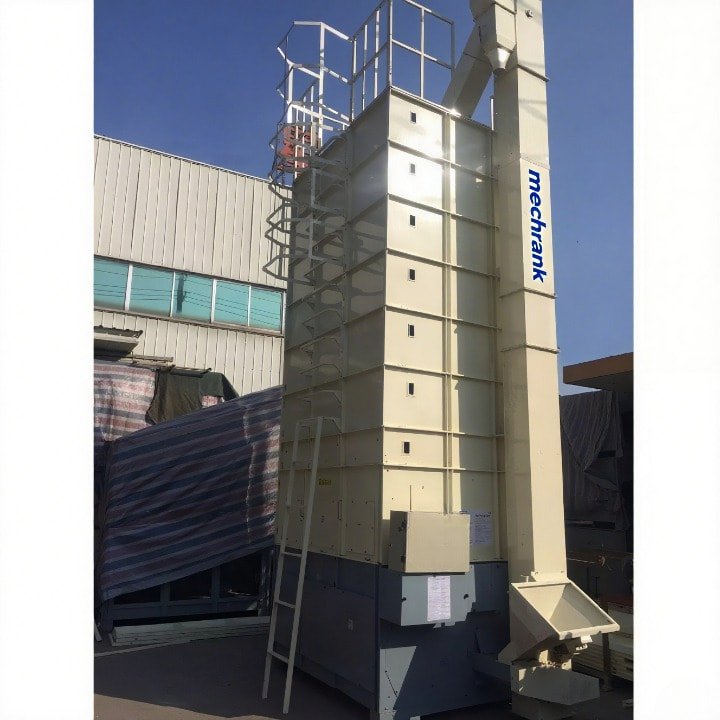
장점
Batch dryers have many good points, especially for small jobs.
다음을 수행할 수 있습니다. dry many kinds of things, even if the items change each time.
Workers can watch each group and change the settings. This helps them get better drying results.
The design is simple, so it is easy to use and fix.
These dryers do not need much space, which is good for small rooms.
They usually cost less to buy and run, so small producers like them.
Workers can change the settings for each group. This helps keep the product good and stops waste.
제한 사항
Batch dryers also have some problems.
Tray dryers, which are common, work best for small amounts and special products. They do not work well for big jobs.
If you need to dry a lot, you need many dryers at once. This means more workers and harder work.
Other machines with more automation need fewer workers than batch dryers.
Workers must load, unload, and clean these dryers by hand. This makes labor cost more.
Starting and stopping often makes them less efficient and not great for big jobs.
Waiting during loading and unloading slows everything down.
For big jobs or drying all the time, other machines may be better and need less work.
일반적인 애플리케이션
People use batch dryers for many things.
They dry plastic pellets that soak up water.
They dry small grains and wet sludges.
They dry foods like fruits, vegetables, meats, and candy.
They dry cereal grains and beans.
Farms everywhere use flat bed-type dryers for grains and beans. These dryers use a screen to hold the crop. Hot air moves through to dry it, but the heat stays low to keep the crop safe. 진공 건조기 are good for things that cannot take much heat, wet sludges, and getting back solvents. Paddle dryers are good for small pieces, and vacuum band dryers work for thin pastes or slurries.
Batch dryers help small farms and producers keep food safe, dry, and ready to store or sell.
How to Select and Maintain a Batch Dryer
When selecting a batch dryer, consider factors such as material type, drying capacity, and energy efficiency. Regular maintenance includes cleaning filters, checking seals, and monitoring temperature controls to ensure optimal performance.
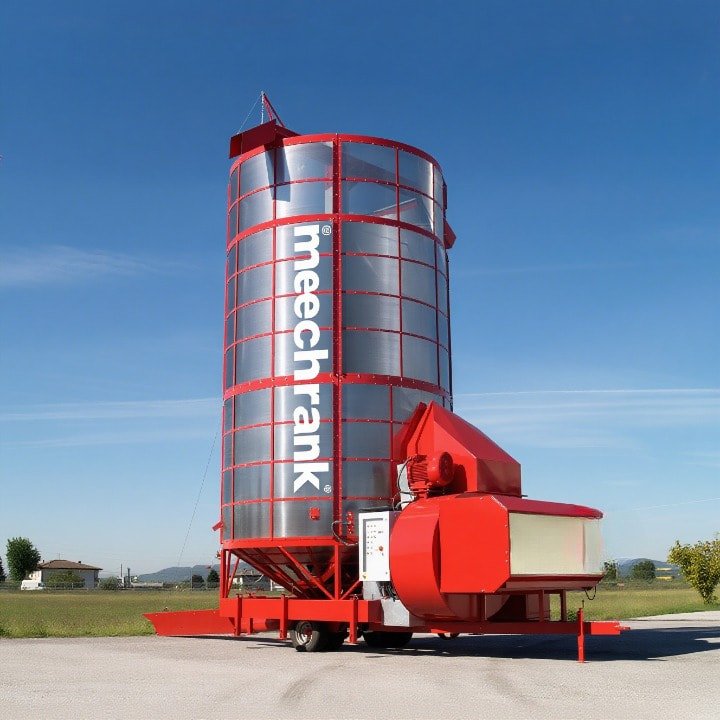
Choosing a Batch Dryer
Picking the right dryer starts with knowing your material. You need to check how wet it is and how heavy it feels. Look at the size of the pieces and if they can handle heat. You also need to see how much space you have in your plant. Think about how much you want to dry each day. Try a small test to see how the material dries. This helps you pick the right size. You should also compare batch and continuous dryers to see which is better for you. Ask people with experience or experts for help.
Other steps are important too:
Check if dust or fire could be a problem. Use a Dust Hazards Analysis.
Think about if the material is toxic or makes bad vapors.
Use indirect drying for dangerous things to keep workers safe.
Think about how much energy, care, and safety each dryer needs.
A table can help you compare dryers:
Specification | Details / Range |
|---|---|
Heat Source | Heat pump, steam, or electric |
Water Removal Rate | |
Rack/Tray Capacity | 8 – 18 racks; 160 – 360 trays |
Product Load per Batch | 800 – 3,600 lbs wet product |
작동 온도 | 80°-160°F (26°-71°C) |
Circulating Fans | 1-3 fans, 24″, 1 HP each |
Electronic Sensors | 2 sensors |
Footprint | Varies by model |
Tip: Pick dryers with good temperature control, save energy, and are easy to clean.
모범 사례
Operators should use good habits to get the best results:
Spread the material out so air can move everywhere and stop wet spots.
Pick the right heat and drying time for each thing you dry.
Watch the sensors and controls to keep drying even.
Write down what happens with each batch to find problems.
Teach workers how to load, unload, and clean safely.
Keeping good notes and teaching workers helps make drying safe and work well.
유지 관리 팁
Taking care of dryers helps them last longer and work better. Here are some main steps:
Clean the chamber and trays after every use. Take out dust and leftover stuff.
Check seals, fans, and ducts for leaks or broken parts.
Clean trays and chambers in food or drug plants to stop germs.
Change air filters and check airflow often.
Make sure temperature and humidity controls are set right.
Oil moving parts and look for worn gears and bearings.
Watch for scale or rust on heating parts and clean them.
Write down every cleaning and repair in a log.
A table shows common problems and how to stop them:
Problem | Cause | Prevention |
|---|---|---|
Minerals in water | Regular cleaning | |
Corrosion | Damaged coatings | Use resistant materials |
Bearing failure | Poor lubrication | Lubricate and inspect bearings |
Feed port blockage | Large or wet lumps | Control feed size and speed |
Uneven drying | Poor material spread | Spread material evenly |
Checking and cleaning often helps stop problems and keeps drying good.
Picking the right dryer helps people use less energy. It also keeps products good and fits what they need. Portable models are good for small farms. They can move around, but they use more energy than big dryers. Cleaning and checking dryers often keeps them safe and working well. Some new dryers have smart controls and green designs. These help save money and make less waste. Many businesses, like meat and seafood, say these dryers make better products and dry things faster.
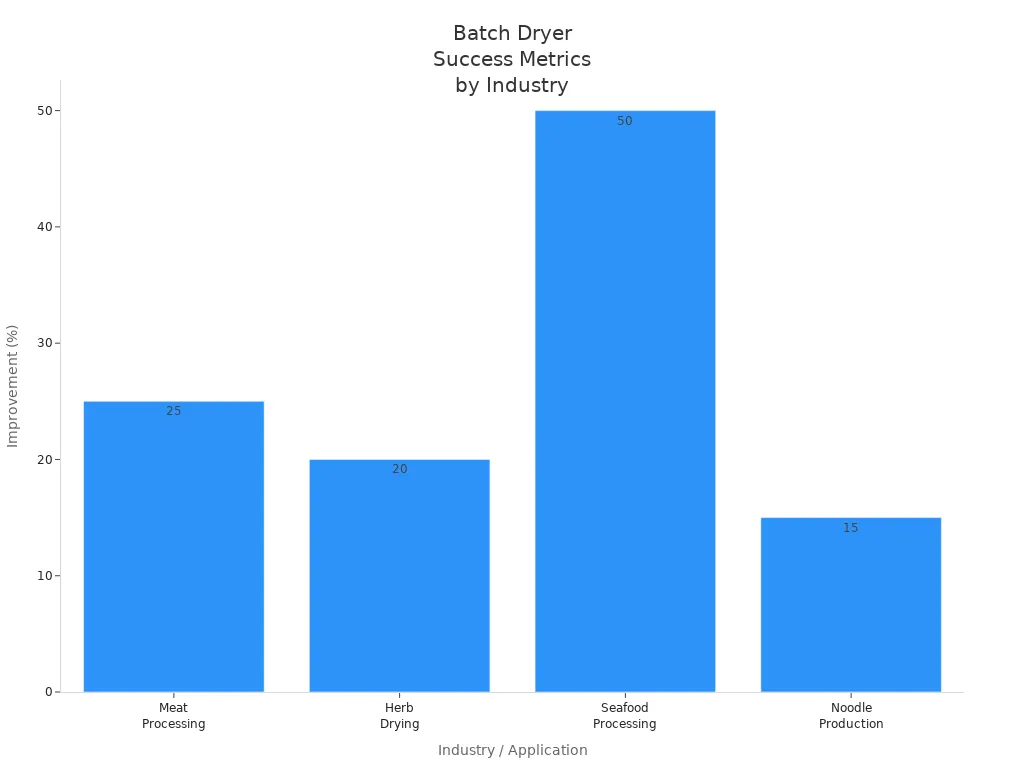
For more help, people can ask research groups, makers, or training centers for tips and news.
자주 묻는 질문
What is the main difference between a batch dryer and a continuous dryer?
A batch dryer dries one group at a time. Workers put in the material, dry it, and then take it out. They must finish one batch before starting another. A continuous dryer works without stopping. Material moves through the machine all the time.
Can batch dryers handle different types of products?
Yes, batch dryers can dry many things. They work for grains, seeds, fruits, vegetables, and chemicals. Operators can change the settings for each batch. This helps match the drying to the product.
How do operators know when a batch is dry?
Operators use sensors or check by hand to see if it is dry. They watch the numbers during drying. When the product is dry enough, they stop the dryer.
Are batch dryers energy efficient?
배치 dryers can save energy if airflow and heat are managed well. Some dryers use solar power or a mix of energy sources. > Tip: Pick the right dryer and keep it clean to use less energy.


